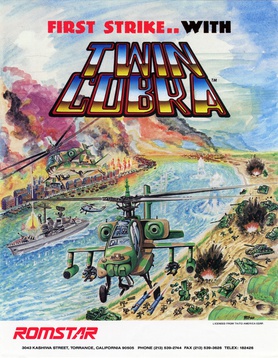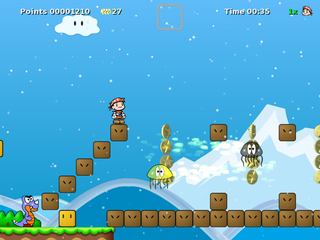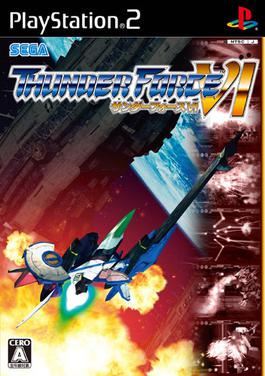Related Research Articles
Shoot 'em ups are a sub-genre of action games. There is no consensus as to which design elements compose a shoot 'em up; some restrict the definition to games featuring spacecraft and certain types of character movement, while others allow a broader definition including characters on foot and a variety of perspectives.
A sports video game is a video game that simulates the practice of sports. Most sports have been recreated with a video games, including team sports, track and field, extreme sports, and combat sports. Some games emphasize actually playing the sport, whilst others emphasize strategy and sport management. Some, such as Need for Speed, Arch Rivals and Punch-Out!!, satirize the sport for comic effect. This genre has been popular throughout the history of video games and is competitive, just like real-world sports. A number of game series feature the names and characteristics of real teams and players, and are updated annually to reflect real-world changes. The sports genre is one of the oldest genres in gaming history.

Border Down is a horizontally scrolling shooter video game developed and published by G.rev. It was released in Japanese arcades in April 2003 on Sega NAOMI hardware, and was ported to the Dreamcast later that year. The story takes place in the future where humans are defending their Mars colony from an invading alien attack. The game employs a "border system" where each stage has three variations of different difficulty. The player starts on the easiest variation, and is lowered to a more difficult variation with each subsequent loss of a life.

Twin Cobra, known as Kyukyoku Tiger in Japan, is a vertically scrolling shooter developed by Toaplan and released for arcades in 1987 by Taito in Japan and Europe, then in North America by Romstar. It is a sequel to the 1985 arcade game Tiger-Heli. Controlling the titular attack helicopter, the players must fight endless waves of military vehicles while avoiding collision with their projectiles and other obstacles. It was the fourth shoot 'em up game from Toaplan, and their tenth video game overall. It was ported to multiple platforms, with each done by different third-party developers that made several changes or additions.

Elevator Action is a platform shooter game released in arcades by Taito in 1983. The player assumes the role of Agent 17, a spy infiltrating a 30-story building filled with elevators and enemy agents who emerge from closed doors. The goal is to collect secret documents from specially marked rooms, then escape the building. It runs on the Taito SJ System arcade system.
The following article is a broad timeline of arcade video games.

The Wonder Boy series, also known as the Monster World series, is a franchise of video games published by Sega and developed by Westone Bit Entertainment. Beginning with the original Wonder Boy arcade game released in April 21, 1986, the game has spawned several sequels released for arcade, Master System, and Sega Genesis, as well as three compilation titles and three remakes by other developers. Several titles have been ported to other consoles by different publishers under different names, most notably Hudson Soft's Adventure Island adaptation of the original game. The main character "Wonder Boy" was named Book by the developer and Tom-Tom by Sega for overseas editions.

A side-scrolling video game is a game viewed from a side-view camera angle where the screen follows the player as they move left or right. The jump from single-screen or flip-screen graphics to scrolling graphics during the golden age of arcade games was a pivotal leap in game design, comparable to the move to 3D graphics during the fifth generation.

Arabian Fight (アラビアンファイト) is a scrolling beat 'em up video game released in arcades by Sega in 1992. Running on the Sega System 32 arcade system, the game displays pseudo-3D sprite-scaling graphics and supports cooperative multiplayer for up to four players.

TwinBee is a vertically scrolling shooter released by Konami as an arcade video game in 1985 in Japan. Along with Sega's Fantasy Zone, released a year later, TwinBee is credited as an early archetype of the "cute 'em up" type in its genre. It was the first game to run on Konami's Bubble System hardware. TwinBee was ported to the Family Computer and MSX in 1986 and has been included in numerous compilations released in later years. The original arcade game was released outside Japan for the first time in the Nintendo DS compilation Konami Classics Series: Arcade Hits. A mobile phone version was released for i-mode Japan phones in 2003 with edited graphics.

Xexex, released as Orius in North America, is a 1991 side-scrolling shoot 'em up arcade game by Konami. It draws on Irem's R-Type and Konami's other shoot 'em up Gradius, while adding the tentacle mechanics of Irem's other shoot 'em up XMultiply. In the game, players take control of the Flintlock space fighter in a mission to rescue Princess Irene La Tias of Planet E-Square, who has been captured by the evil galactic warlord Klaus Pachelbel.

Galaxy Force is a rail shooter video game developed and released by Sega for arcades in 1988. The player assumes control of a starship named the TRY-Z, as it must prevent the Fourth Empire from taking over the entire galaxy. Gameplay involves shooting down enemies using either a laser shot or a limited supply of heat-seeking missiles, all while avoiding collision with projectiles or obstacles and making sure the ship's energy meter doesn't fully deplete. It ran on the Sega Y Board arcade system, and was released with a motion simulator cockpit arcade cabinet version like previous Sega Super Scaler games.

Thunder Force VI is a 2008 horizontal-scrolling shooter video game developed and published for the PlayStation 2 by Sega. The game places the player in the role of a starship that must eradicate the Orn Faust empire before they destroy all of Earth. The player must complete each stage by shooting down enemies and avoiding collisions with them and their projectiles, using an arsenal of powerful weapons to destroy them. It is the sixth and final entry in the long-running Thunder Force video game franchise, and the only one to not be developed by series creator Technosoft.

Thunder Blade is a third-person shoot 'em up video game released by Sega for arcades in 1987. Players control a helicopter to destroy enemy vehicles. The game was released as a standard stand-up arcade cabinet with force feedback, as the joystick vibrates. A helicopter shaped sit-down model was released, replacing the force feedback with a cockpit seat that moves in tandem with the joystick. It is a motion simulator cabinet, like the previous Sega Super Scaler games Space Harrier (1985) and After Burner (1987). The game's plot and setting was inspired by the film Blue Thunder (1983).

M2 Co., Ltd. is a Japanese video game developer and publisher, best known for handling emulation of re-released games, such as some Sega Ages titles, Virtual Console titles for Nintendo systems, the 3D Classics series for the Nintendo 3DS and their ShotTriggers range of classic STG games. M2 has also created entirely new titles such as WiiWare games for Konami under the ReBirth moniker and more recently a new GG Aleste game. In addition, M2 currently holds the rights of Aleste series and all NEC Avenue and NEC Interchannel games on TurboGrafx-16 and variants, previously owned by Lightweight.
A cover system is a video game gameplay mechanic that allows a virtual avatar to hide from and avoid dangers, usually in a three-dimensional world. This method is a digital adaptation of the real-life military tactic of taking cover behind obstacles, for purposes of attaining protection from enemy ranged or area effect attacks, such as gunfire or explosions.

Video games are a major industry in Japan, and the country is considered one of the most influential in video gaming. Japanese game development is often identified with the golden age of video games, including Nintendo under Shigeru Miyamoto and Hiroshi Yamauchi, Sega during the same time period, Sony Computer Entertainment when it was based in Tokyo, and other companies such as Taito, Bandai Namco Entertainment, Capcom, Square Enix, Konami, NEC, and SNK, among others.

Dino Rex is a fighting arcade video game developed and originally released by Taito in Japan on November 1992. Set during the 25th century BC on a prehistoric South America, players assume the role of a warrior commanding his dinosaur companion as he enters a tournament held by the current titular king in order to become the next ruler while facing matches against other rivals. Its gameplay consists of one-on-one fights, with a main three-button configuration, featuring special moves and combo techniques.
References
- 1 2 3 "Hardcore Gaming 101 Seeks Funding For Obscure Japanese Games Book". IGN India. 2017-10-17. Archived from the original on 2021-07-14. Retrieved 2021-07-14.
- 1 2 Jong, Philip (August 20, 2011). "Kurt Kalata - Hardcore Gaming 101 - Interview - Adventure Classic Gaming". www.adventureclassicgaming.com. Archived from the original on 2011-10-14. Retrieved 2021-07-14.
- 1 2 "Book Review: The 200 Best Video Games Of All Time". Nintendo Life. 2016-01-12. Archived from the original on 2021-07-14. Retrieved 2021-07-14.
- ↑ "Book Review: Sega Arcade Classics Volume 1". Nintendo Life. 2013-01-18. Archived from the original on 2021-07-14. Retrieved 2021-07-14.
- 1 2 "Hardcore Gaming 101's Next Book Focuses On Taito's Arcade Legacy". Nintendo Life. 2016-01-20. Archived from the original on 2021-07-14. Retrieved 2021-07-14.
- ↑ "Book Review: The Unofficial Guide To Konami Shooters". Nintendo Life. 2016-07-14. Archived from the original on 2023-08-30. Retrieved 2021-07-14.
- ↑ "Book Review: Hardcore Gaming 101 Presents Data East Arcade Classics". Nintendo Life. 2016-09-23. Archived from the original on 2021-07-14. Retrieved 2021-07-14.
- ↑ "Book Review: Hardcore Gaming 101 Presents: The Guide To Shoot-Em-Ups Volume 1". Nintendo Life. 2017-01-11. Archived from the original on 2021-07-14. Retrieved 2021-07-14.
- ↑ "Mega Man: A Transmission from Another World". The Escapist. 2010-04-27. Archived from the original on 2021-07-14. Retrieved 2021-07-14.
- ↑ "Hardcore Gaming 101 Unveils Top 250 Western Gaming Tunes". The Escapist. 2011-12-23. Archived from the original on 2021-07-14. Retrieved 2021-07-14.
- ↑ "History of pre-Street Fighter II pugilism sims; wow, the past really sucked". Destructoid. 2007-07-06. Retrieved 2021-07-14.